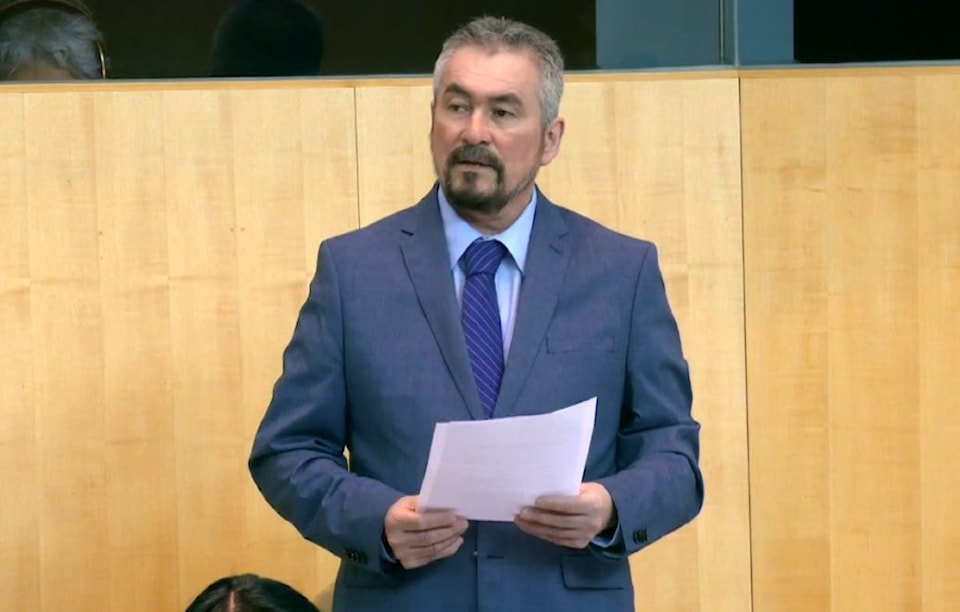More action is needed to bring biomass heating systems to homes in the NWT, said MLAs in the legislative assembly Wednesday.
During the assembly session dedicated to housing, Dehcho MLA Ron Bonnetrouge said biomass heating systems, such as wood-pellet boilers, reduce reliance on imported fossil fuels, cut fuel consumption and greenhouse gas emissions and provide savings to utility costs for the Northwest Territories Housing Corporation (NWTHC).
Biomass strategy needed
However, Bonnetrouge said he senses reluctance from the housing corporation to commit to a biomass energy strategy to reduce greenhouse gas emissions.
Housing Minister Paulie Chinna responded that energy efficiency and savings are “huge considerations” for the NWTHC when it builds and retrofits its units.
While providing few specifics, Chinna said the NWTHC is looking to decrease fuel use in housing projects and has replaced all of the light bulbs in its units.
Efficiency projects underway
In a Committee of the Whole meeting after the session, NWTHC vice-president Jim Martin outlined some actions the agency is taking to enhance energy efficiency in its projects.
“Within the next week or two,” Martin said, “we are going to be hopefully awarding a tender for a major biomass project here in Yellowknife. It's going to involve 53 housing units. We're converting 45 oil fire furnaces over to biomass, and we're hooking up this system to a new eight-plex singles building that we're delivering in town.”
The federal government is providing up to 75 per cent of the cost for the project at Sissons Court, with the NWTHC providing 25 per cent of the cost, said an NWTHC spokesperson in an email to NNSL Media.
Construction is expected to be complete by the fall of 2021.
Martin also mentioned the NWTHC's work with Aklavik's biomass project, where it connected several public housing units to the hamlet's heating system.
That project was completed in January of 2021 and the corporation connected a nine-plex building to the system and is paying the hamlet for the heat.
In addition, the NWTHC invested in solar panel systems in Inuvik, Hay River, Fort Simpson, Fort Liard and Whati; owns and operates biomass systems in Dettah, Ndilo and Fort Resolution; and is connected to third party systems in Behchoko.
The spokesperson added that the NWTHC is developing a three-year energy action plan scheduled to be released this spring that will include the use and support of biomass heating.
Chinna said she's open to having further conversations on the issue. She also committed to presenting the heating strategy to her federal counterparts and the Canada Mortgage and Housing Corporation.
“Looking at the cost of living for the NWT and the affordability up to our higher, Arctic communities, this would be a significant approach that I will have a conversation with Canada about,” she said.
Better options for biomass
Frame Lake MLA Kevin O'Reilly raised the issue of the potential difficulties in securing insurance in homes with biomass heating systems, after his own policy was cancelled due to the fact that he had installed a wood-pellet boiler five years ago.
NWTHC president Tom Williams said the corporation is looking at that risk in its home ownership programs and is working with the Department of Finance to find solutions.
“I think it's more educating people on the merits of insurance and educating the insurance companies, the providers, that they are losing out on a huge market if they don't adjust their policies for our realities here in the North,” he said.
Speaking about biomass fuels, O'Reilly then touted wood chips as an alternative to wood pellets because the chips could be more accessible in remote communities and don't have to be converted to pellets.
“You can go down and harvest willows beside the river, and you can turn them into wood chips and burn them,” he said.
Chinna responded that the NWTHC is currently working only with pellets and the chips would be something for further discussions.
O'Reilly urged the corporation to be more proactive with biomass solutions and not wait for others to approach them.
“If you have a new four-plex you are setting up in a community that does have potential access to wood chips, look at it as a potential. Do it as a pilot project. I am sure you could partner with Aurora Research Institute and Arctic Energy Alliance. I think there would be money out there to do that kind of stuff.”
Biomass part of Energy Strategy
Pellet boiler projects are part of the GNWT's 2030 Energy Strategy Action Plan, explained Infrastructure Minister Diane Archie in October of 2020. Some recent examples of those projects include two boilers scheduled to be installed at Mildred Hall and Range Lake North schools in Yellowknife and funding for energy efficiency projects in three town buildings in Fort Smith.
Pellet boilers have also been installed at 12 government buildings in Yellowknife over the last several years. The first one installed was in 2006 at the North Slave Correctional Facility, said department spokesperson Greg Hanna.
Others have been set up in Stanton Territorial Hospital, Prince of Wales Northern Heritage Centre and at the legislature.
With more than 30 pellet boiler installations across the territory, Hanna estimated that $1.5 million in heating bills had been saved, and 9,000 tonnes of greenhouse gases offset annually.
An Infrastructure Department study examining the use of biofuels for transportation, space heating and power generation in the NWT is due to be completed early this year, said department spokesperson Agata Gutkowska.
Ethanol and renewable diesel were the two biofuels chosen for further analysis in the study.
